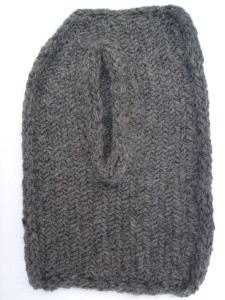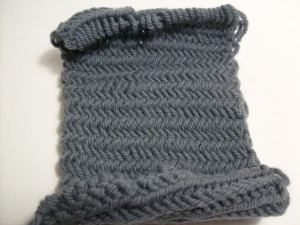I became intrigued by the Miniature Herringbone Stitch during Christmas of 1990. I’d never seen it in a magazine pattern but I was sure that I would knit my new yarn in it. By the time I knew why this stitch wasn’t used more often, the sweater I did make from that yarn had long been a wardrobe staple, and my copy of the Second Treasury of Knitted Patterns fell open to Miniature Herringbone Stitch automatically.
Barbara G Walker calls this stitch super dense, she recommends using fairly large needles in proportion to the weight of the yarn, and making mittens, pot holders and long-wearing slippers from it.
(I would add, you can also make a rather lovely skirt too)
Miniature Herringbone Stitch Instructions (flat)
Any number of stitches
Row 1:* Insert the needle into the first two stitches through the back loops, draw up a stitch,remove only one stitch from your left needle. * Repeat from * until there is one stitch left on the needle. Knit the last stitch.
Row 2:* Insert the needle into the first two stitches purl wise. Draw up a purl stitch removeonly one stitch from your left needle. * Repeat from * until there is one stitch left on the needle. Purl that last stitch.
(note, except for that last stitch of every row, each stitch is worked twice before being dropped from the needle.)
Miniature Herringbone Stitch In the Round
Any number of stitches
Round 1:* Insert the needle into the first two stitches through the back loops, draw up a stitch, remove only one stitch from your left needle. * Repeat from *.
Round 2:* Insert the needle into the first two stitches through the front loops, draw up a stitch, remove only one stitch from your left needle. * Repeat from *.
My first swatch attempt was impossibly tight. Mrs Walker wasn’t kidding about needing larger than usual needles. I found the US 10.5 needles I’d bought for a lopi project, they were just right for my worsted weight Balley Brae. The face side of the fabric was almost flat. The reverse did not look at all like a purl stockinette, more like a deeply ridged rib, sideways. This stitch ate yarn, it was as if I were crocheting, not knitting.
The selvages had odd loops every other row – I think from the last stitch being knit single. It didn’t curl like a piece of stockinette would have, middle rolling up with the purl side out, edges flaring with knit side out, instead it rolled up with the reverse side on the outside top to bottom like a scroll. The proportions of rows and stitches were nothing like a stockinette swatch of the same yarn. While a typical swatch of stockinette will have 5 stitches for every 7 rows (with huge variations for yarn, individual, and knitting technique) my MHB swatches have 3 stitches for every 2 rows. In the stretchiness department, a 5 inch section of MHB stretched to 8.5 inches across a row, while a 5 inch section stretched to 9 inches across the courses.
So how to tame the selvages, deal with the unusual stretch direction and make it work in a garment? I plan to cover all that in the days ahead, but my main point is that this fabric looks woven, but it is knitted; and that is magic.


